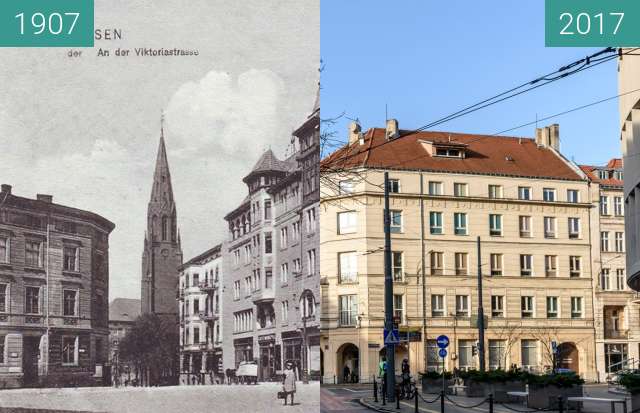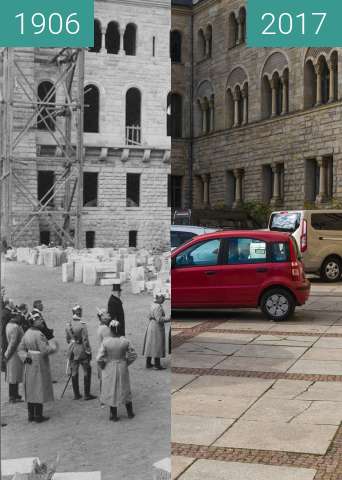Ulica Fredry, kościół Św. Pawła
© Narodowe Archiwum Cyfrowe
POL
near Poznań
Fetching images...










Kościół Najświętszego Zbawiciela – zabytkowa świątynia przy ul. Fredry 11 w Dzielnicy Cesarskiej w Poznaniu, wzniesiona w latach 1866–1869 w stylu neogotyckim według projektu Augusta Stülera i wykonującego plany szczegółowe Juliusza Hochbergera dla parafii ewangelicko-augsburskiej. Fundatorem był Fryderyk Wilhelm IV, który na ten cel przeznaczył sumę ponad 56 tysięcy talarów. Początkowo kościół nosił wezwanie św. Pawła, jednak po zajęciu go w 1945 przez katolików zmieniono wezwanie na obecne (św. Paweł był już patronem bazyliki archikatedralnej). W 1950 abp Walenty Dymek erygował tu nową parafię. Renowacja po zniszczeniach wojennych zakończyła się dopiero w 1964 roku.
Wnętrze
Z zewnątrz najbardziej charakterystycznym elementem jest wznosząca się na 70 m wieża (krzyż na jej szczycie ma 2,6 m wysokości). W neogotyckim portalu tondo przedstawiające głowę Chrystusa, powyżej rozeta. Wnętrze trójnawowe, przykryte sklepieniem gwiaździstym w nawie głównej, a sklepieniem krzyżowym w nawach bocznych. Z pierwotnego wystroju pozostały jedynie skrócone empory, chrzcielnica wykonana pomiędzy 1867 a 1869 oraz prospekt organowy z 1912 roku. Witraże w prezbiterium pochodzą z 1959 roku, a ich autorem jest Józef Oźmin. Te znajdujące się w prezbiterium przedstawiają Adorację Dzieciątka Jezus, Zdjęcie z krzyża i Wniebowstąpienie. W prezbiterium rzeźba przedstawiająca Pasję dłuta Lecha Czuba. W lewym ołtarzu bocznym przedstawienie Niepokalanego Serca Najświętszej Marii Panny, zaś po prawej Miłosierdzia Bożego. Po bokach od ołtarzy obrazy Matki Boskiej Nieustającej Pomocy i św. Tadeusza Judy
Przy kościele znajduje się Głaz Piotra Majchrzaka z inskrypcją: Jeśli ludzie zamilkną, kamienie wołać będą, poświęcony Piotrowi Majchrzakowi, który 11 marca 1982, w wieku 19 lat, został pobity przez ZOMO. Zmarł 18 marca. Przy kościele przed dawną pastorówką (dziś domem parafialnym), zbudowaną w latach 1886–1887, znajduje się odsłonięty w 2000 roku pomnik Jezusa Chrystusa autorstwa Eugeniusza Olechowskiego upamiętniający dwa tysiące lat chrześcijaństwa i 50-lecie parafii.
Obecnie wielu uważa kościół za jedno z najważniejszych dzieł XIX-wiecznego neogotyku w Polsce.
Od 2017 r. wielkopostny kościół stacyjny.
Na terenie dawnego cmentarza ewangelickiego parafii św. Pawła przy ul. Grunwaldzkiej (obecnie Park Manitiusa) zachowała się kaplica z 1896 roku.
Źródło: https://pl.wikipedia.org/wiki/Ko%C5%9Bci%C3%B3%C5%82_Naj%C5%9Bwi%C4%99tszego_Zbawiciela_w_Poznaniu
Church of the Holy Savior - a historic temple at ul. Fredry 11 in the Imperial Quarter in Poznań, erected in 1866-1869 in the neo-Gothic style according to the design of August Stüler and making detailed plans of Juliusz Hochberger for the Evangelical-Augsburg parish. The founder was Fryderyk Wilhelm IV, who for this purpose allocated a sum of over 56 thousand thalers. Initially, the church wore the call of Saint. Paweł, however, after being taken over by Catholics in 1945, the invitation to the present was changed (St. Paul was already the patron of the archcathedral basilica). In 1950, Archbishop Walenty Dymek erected a new parish here. Renovation after war damage ended only in 1964.
Interior
From the outside, the most characteristic element is the tower rising to 70 m (the cross at the top is 2.6 m high). In the neogothic tondo portal depicting the head of Christ, above the rosette. Three-nave interior, covered with a star vault in the main nave, and a cross vault in the aisles. Only the shortened galleries, the baptismal font made between 1867 and 1869, and the organ prospectus from 1912 remained from the original interior. Stained glass windows in the presbytery come from 1959, and their author is Józef Oźmin. Those in the presbytery show the Adoration of the Baby Jesus, Photo of the Cross and Ascension. In the presbytery, a sculpture depicting the passion of Lech Czuba. In the left side altar, a representation of the Immaculate Heart of the Blessed Virgin Mary, and on the right the Divine Mercy. On the sides of the altars, the images of Our Lady of Perpetual Help and Saint. Tadeusz Judy
Next to the church is the Boulder of Piotr Majchrzak with the inscription: If people stop talking, the stones will cry, dedicated to Piotr Majchrzak, who on March 11, 1982, at the age of 19, was beaten by ZOMO. He died on March 18. At the church in front of the former pastor (now a parish house), built in 1886-1887, there is the statue of Jesus Christ unveiled in 2000 by Eugeniusz Olechowski, commemorating two thousand years of Christianity and the 50th anniversary of the parish.
Currently, many consider the church as one of the most important works of the nineteenth-century neo-Gothic in Poland.
From 2017, the Lenten Stave Church.
In the former cemetery of the Evangelical parish of Saint. Paweł at ul. Grunwald (now Park Manitiusa) the chapel from 1896 has survived.
Source: https://pl.wikipedia.org/wiki/Ko%C5%9Bci%C3%C3%82_Naj%C5%9Bwiwi%sz4wszego_Zbawiciela_w_Poznaniu